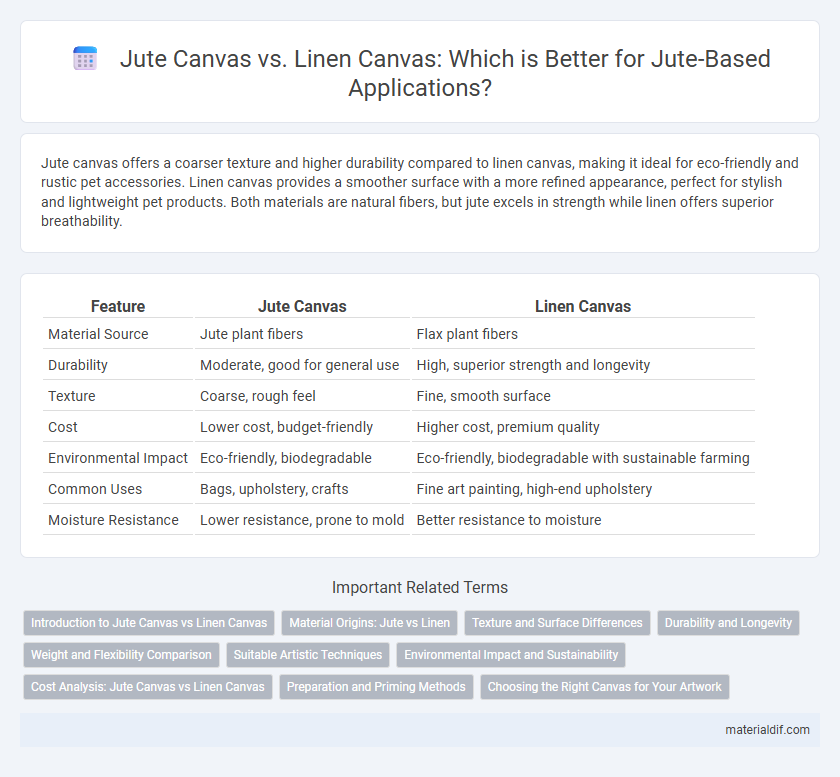Jute canvas offers a coarser texture and higher durability compared to linen canvas, making it ideal for eco-friendly and rustic pet accessories. Linen canvas provides a smoother surface with a more refined appearance, perfect for stylish and lightweight pet products. Both materials are natural fibers, but jute excels in strength while linen offers superior breathability.
Table of Comparison
| Feature | Jute Canvas | Linen Canvas |
|---|---|---|
| Material Source | Jute plant fibers | Flax plant fibers |
| Durability | Moderate, good for general use | High, superior strength and longevity |
| Texture | Coarse, rough feel | Fine, smooth surface |
| Cost | Lower cost, budget-friendly | Higher cost, premium quality |
| Environmental Impact | Eco-friendly, biodegradable | Eco-friendly, biodegradable with sustainable farming |
| Common Uses | Bags, upholstery, crafts | Fine art painting, high-end upholstery |
| Moisture Resistance | Lower resistance, prone to mold | Better resistance to moisture |
Introduction to Jute Canvas vs Linen Canvas
Jute canvas offers a coarse texture and high durability, making it ideal for eco-friendly packaging and durable bags, while linen canvas provides a finer weave and smoother surface favored in high-quality art and upholstery projects. Jute fibers are derived from the Corchorus plant, known for rapid growth and biodegradability, whereas linen is made from flax fibers, prized for strength and moisture resistance. Both materials serve distinct purposes based on their fiber structure, texture, and environmental footprint.
Material Origins: Jute vs Linen
Jute canvas, derived from the fibers of the Corchorus plant, is known for its coarse texture and natural golden color, making it a sustainable and eco-friendly choice. In contrast, linen canvas originates from flax fibers, offering a finer weave and smoother surface valued in high-quality art and upholstery applications. The distinct botanical sources influence durability, breathability, and suitability for different artistic and industrial uses.
Texture and Surface Differences
Jute canvas features a coarse and fibrous texture with a rough surface that provides a natural, rustic appearance, making it ideal for projects emphasizing organic aesthetics. Linen canvas offers a smoother, tighter weave with a finer surface that supports detailed artwork and durability, favored by professional artists seeking precision. The distinct texture and surface qualities of jute versus linen canvas influence their suitability for different artistic and functional applications.
Durability and Longevity
Jute canvas offers moderate durability with its coarse fibers, making it suitable for short-term projects but prone to wear and tear over extended use. Linen canvas, derived from flax fibers, boasts superior strength and longevity, resisting stretching and degradation even after decades, making it the preferred choice for high-quality, lasting artworks. The tightly woven structure of linen enhances its durability compared to the looser weave of jute, ensuring better preservation and resilience.
Weight and Flexibility Comparison
Jute canvas typically weighs between 9 to 12 ounces per square yard, making it heavier and more durable compared to linen canvas, which usually ranges from 7 to 11 ounces per square yard. Linen canvas offers superior flexibility and a smoother texture ideal for detailed artwork, whereas jute canvas is stiffer and more coarse, suited for rugged applications. The weight difference impacts flexibility, with linen bending more easily due to its finer fiber structure and jute's denser weave providing greater rigidity.
Suitable Artistic Techniques
Jute canvas is ideal for rustic and textured paintings, excelling in acrylic and mixed media techniques due to its coarse weave and absorbent surface. Linen canvas offers a smoother, fine-grain texture perfect for detailed oil painting and delicate watercolor washes, providing superior durability and a refined finish. Artists seeking rich textures often prefer jute, while those requiring precision and longevity choose linen for their canvases.
Environmental Impact and Sustainability
Jute canvas is highly sustainable due to its rapid growth cycle, minimal need for pesticides, and fully biodegradable fibers, making it an eco-friendly alternative to linen canvas. Linen canvas, derived from flax plants, requires more intensive water usage and agrochemicals, resulting in a higher environmental footprint compared to jute. Both canvases offer durability, but jute's lower resource demands and carbon footprint position it as a greener option for environmentally conscious consumers.
Cost Analysis: Jute Canvas vs Linen Canvas
Jute canvas offers a more budget-friendly option compared to linen canvas, with prices typically 30-50% lower depending on quality and sourcing. While linen canvas provides superior durability and a smoother texture favored by professional artists, its higher production costs drive the price difference. For applications requiring cost efficiency without sacrificing basic functionality, jute canvas represents an economically viable alternative to the premium linen canvas.
Preparation and Priming Methods
Jute canvas requires thorough cleaning and a strong, flexible primer like acrylic gesso to seal its coarse, loose fibers effectively, preventing paint absorption and ensuring durability. Linen canvas, known for its tight weave and smooth surface, typically demands a lighter, more refined priming approach using rabbit skin glue or acrylic gesso, preserving its natural texture while enhancing paint adhesion. Both fabrics benefit from an initial sanding after priming to enhance surface uniformity and optimize paint application.
Choosing the Right Canvas for Your Artwork
Jute canvas offers a coarse texture and high durability making it ideal for rustic or textured artworks requiring strong fiber support. Linen canvas provides a smoother, finer surface preferred by professional artists for detailed paintings and archival quality due to its natural strength and resistance to aging. Choosing between jute and linen canvas depends on the desired texture, longevity, and the medium applied in your artwork.
Jute Canvas vs Linen Canvas Infographic

 materialdif.com
materialdif.com